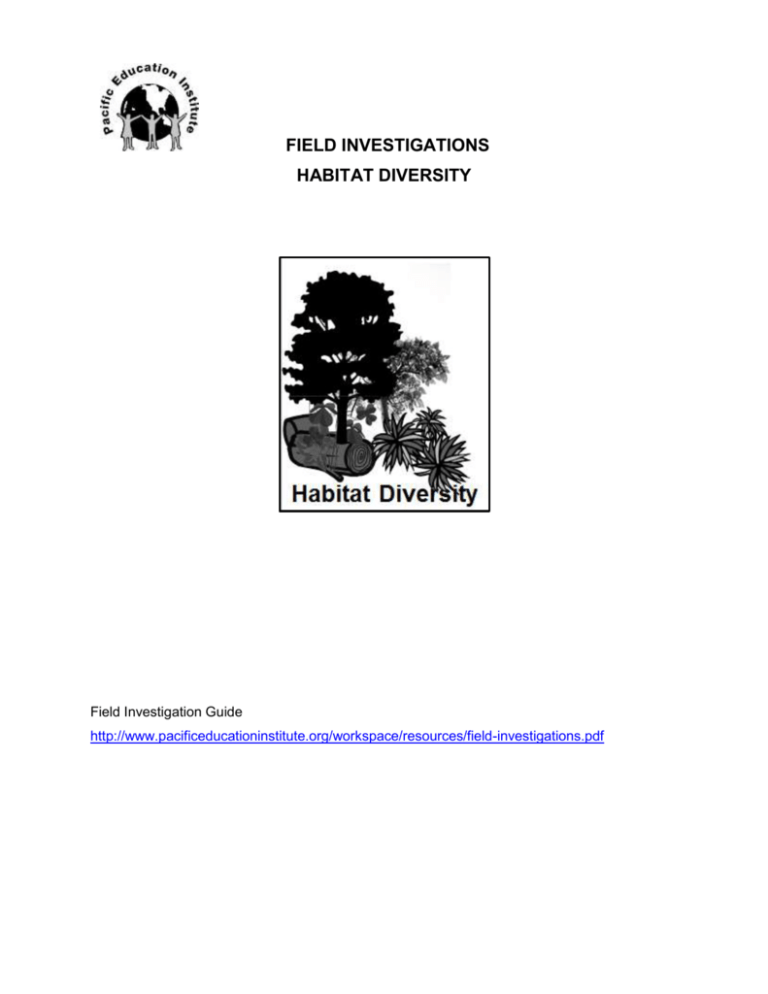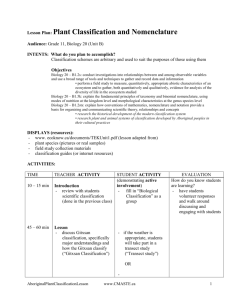Planet Diversity #9
advertisement

FIELD INVESTIGATIONS HABITAT DIVERSITY Field Investigation Guide http://www.pacificeducationinstitute.org/workspace/resources/field-investigations.pdf Draw and label a local ecosystem. Then ask ecosystem questions. Ecosystem Questions What are the parts of the local ecosystem? What role/function do the plants in the ecosystem play? Identify transfers or transformation of energy in the ecosystem. What are some inputs and outputs to the local ecosystem? What is the energy source that runs the local system? Name subsystems within the local ecosystem. What might happen if the _____ died in this local ecosystem? Is the local ecosystem an open or closed system? Why? Describe interactions between plants and animals in the ecosystem. Between living and non-living components Plant Diversity Investigation Essential question: Descriptive field investigation question: What plants live in the habitat? Assign students 3-7 plants and give them plant ID cards or books to use to identify them Choose a site along a path for each group of students Materials: Map of area to show locations of sites would be wonderful, but not required to do activity Meter Stick or dowel Tape measure or string 5 meters long Tape measure to measure area covered or circumference of trees Plant ID cards or books Clip boards Thermometer Recording sheets Procedure: 1. Choose a site for each group in the habitat that is being studied. 2. Divide students into groups of 2-3 3. Choose 3-7 plants for each group to count/measure along the transect line 4. Have students determine the location of the study site 5. Have students describe the study site and measure and record the temperature 6. Have students lay out the string 5 meters through the habitat. 7. Students then count the type and number of plants and record. Descriptive field investigation of plants in_______________habitat Question______________________________________________ _____________________________________________________ Location______________________________________________ Site Description_________________________________________ Date__________________Air Temperature _______________ Weather______________________________________________ Type of Plant # of plants along 5 meter transect or distance covered Question: Which habitat: ______________________, or _______________________, has the greater diversity of plants (number of different types of plants) at ________________ (location)? Prediction:_______________________________________________________________________ Date______________________Time____________Weather___________________ Study site (location) ___________________Study site Description ____________________________ Materials: _____________________________________________________________________ Habitat vs. Diversity of Plants Diversity of plants-Numbers of different types Habitat Transect 1 Transect 2 Transect 3 Transect 4 Transect 5 Transect 6 Ave Number of different types of plants Habitat Diversity Graph Habitat Diversity Conclusion Which habitat: __________, or __________, has the greater diversity of plants (number of different types of plants) at (location)? Limit conclusion to place, date, and time of investigation A conclusive statement clearly answers the investigation question Or answers the prediction Supporting data for lowest condition Supporting data for the highest condition or trend data Explanatory Language Discussion Discuss factors that may have influenced data Discuss improvements to the procedure to control some of those factors Explain any inconsistent data Explain how this information might be important in the real world Explain how this information should inform actions or decisions Cite further questions for investigation What are other biotic or abiotic factors we could measure on this site? How does the Diversity investigation help me understand the local ecosystem? o What are the benefits of plant diversity in parks or urban landscapes?







